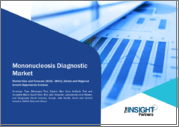
|
시장보고서
상품코드
1819720
엡스테인 바 바이러스 시장 - 세계 및 지역별 분석 : 지역별 - 분석과 예측(2025-2035년)Epstein Barr Virus Market - A Global and Regional Analysis: Focus on Country and Region - Analysis and Forecast, 2025-2035 |
||||||
세계 엡스타인 바 바이러스 시장 - 분석 및 예측(2025-2035)
엡스타인 바 바이러스(EBV)는 헤르페스 바이러스과에 속하는 흔한 바이러스로, 전 세계 인구의 90% 이상이 일생 중 한 번 이상 감염된 적이 있습니다.
EBV는 주로 타액을 통해 감염되지만 혈액, 장기 이식, 성접촉을 통해서도 감염될 수 있습니다. 대부분의 감염은 무증상이거나 전염성 단핵구증과 같은 경미한 증상이지만, EBV는 버킷 림프종, 호지킨 림프종, 상인두암과 같은 다양한 암, 자가면역질환, 만성질환 등 더 심각한 증상과 관련이 있습니다. 바이러스는 최초 감염 후에도 체내에서 휴면상태로 남아 있다가 나중에 다시 활성화되어 합병증을 유발할 수 있습니다. 현재 EBV에 대한 백신은 없으며, 치료는 일반적으로 증상 및 관련 질환의 관리에 중점을 둔 지지요법입니다.
엡스타인 바 바이러스(EBV) 시장은 다양한 질병에서 바이러스의 역할에 대한 인식이 높아지고 엡스타인 바 바이러스와 관련된 암 및 자가면역질환의 발생률이 증가함에 따라 주도되고 있습니다. 이러한 질병과 엡스타인 바 바이러스의 연관성에 대한 인식이 높아지면서 엡스타인 바 바이러스 감염을 예방하거나 관리할 수 있는 진단 도구, 항바이러스 요법, 백신에 대한 수요가 증가하고 있습니다. 또한, EBV와 관련된 악성 종양 및 만성질환에 특이적으로 대처할 수 있는 표적 치료제 개발 연구가 진행되고 있는 것도 이 시장의 성장 동력이 되고 있습니다. 면역요법과 맞춤의료의 발달로 보다 효과적인 치료의 새로운 길이 열리고 있는 가운데, 엡스타인 바 바이러스 백신의 개발 가능성은 바이러스와 관련된 장기적인 합병증을 예방할 수 있는 획기적인 해결책이 될 수 있을 것으로 보입니다.
엡스타인 바 바이러스 시장의 주요 촉진요인 중 하나는 EBV와 관련된 암 및 자가면역질환의 부담이 증가하고 있다는 점입니다. EBV는 림프종, 상인두암을 포함한 일부 암과 다발성 경화증, 전신성 홍반성 루푸스 등 자가면역질환의 발병에 기여하는 것으로 알려져 있습니다. 이러한 질환의 유병률이 증가함에 따라, 특히 EBV와 이러한 질환의 연관성이 더욱 확립됨에 따라 보다 효과적인 진단 및 치료법에 대한 수요가 증가하고 있습니다. 또한, 항바이러스제 및 면역 조절 치료와 같은 표적 치료제의 개발은 EBV와 관련된 건강 문제를 관리할 수 있는 새로운 가능성을 열어 시장 성장을 더욱 촉진하고 있습니다.
엡스타인 바 바이러스 시장에는 기회가 있음에도 불구하고 몇 가지 과제도 남아있습니다. 첫 번째 장벽은 EBV 관련 질환의 복잡성입니다. EBV는 다양한 증상을 보이는 광범위한 질병에 관여하고 있습니다. 이러한 다양성으로 인해 보편적인 치료 전략의 개발이 어렵고, 치료법은 환자가 겪고 있는 특정 EBV 관련 질환에 따라 환자 개개인에 맞게 조정되어야 합니다. 또 다른 과제는 엡스타인 바 바이러스를 특이적으로 표적으로 하는 효과적인 항바이러스 치료제가 없다는 것입니다. 항바이러스제는 존재하지만, 바이러스 자체의 치료나 재활성화 예방에 보편적으로 효과가 있는 것은 아닙니다. 또한, 엡스타인 바 바이러스 백신 개발이 어려운 것으로 밝혀졌습니다. 바이러스는 면역 체계를 회피하는 독특한 능력을 가지고 있기 때문에 부작용을 일으키지 않고 장기적인 방어력을 제공하는 백신을 설계하는 것은 어렵습니다.
또 다른 과제는 EBV 관련 질환의 진단 도구와 첨단 치료법의 높은 비용입니다. 혈청학적 분석이나 분자진단 등 현재 사용되는 많은 진단 검사는 고가이며, 자원이 한정된 환경에서는 사용할 수 없는 경우가 많습니다. 특히 EBV와 관련된 암과 자가면역질환의 치료비는 환자와 의료시스템에 큰 부담이 되고 있습니다. 또한, 선별검사 프로그램이나 조기 발견법이 널리 보급되지 않아 EBV와 관련된 많은 질병이 효과적인 치료가 어려운 시기에 진단되는 경우가 많습니다.
세계 엡스타인 바 바이러스 시장은 경쟁이 치열하며, 여러 주요 기업들이 기술 혁신과 시장 성장을 주도하고 있습니다. AstrViracta Therapeutics, Atara Biotherapeutic, AlloVir, Pierre Fabre 등 주요 기업들이 시장의 최전선에 있으며, 각각 혁신적인 치료제, 의료기기, 치료를 통해 기여하고 있습니다. 엡스타인 바 바이러스(EBV) 시장의 기업들은 첨단 항바이러스 치료와 면역 조절 치료의 가용성을 확대하는 데 주력하고 있습니다. 이러한 기업들이 조사개발에 지속적으로 투자하는 가운데, EBV 치료제 시장 내 경쟁은 더 많은 기술 혁신을 촉진하고, 궁극적으로 더 효과적인 치료법, 더 나은 환자 결과, EBV 관련 질환을 앓고 있는 사람들의 삶의 질 향상으로 이어질 것입니다.
엡스타인 바 바이러스 시장 세분화
세분화 1 : 지역별
- 북미
- 유럽
- 아시아태평양
바이러스의 복잡한 생물학 및 여러 질병에 대한 관여를 밝히기 위해 민관 모두 EBV 연구에 막대한 자금을 투입하고 있습니다. 연구 이니셔티브의 확대는 항바이러스제, 백신, 바이러스 재활성화를 방지하는 치료법 등 EBV 치료의 돌파구를 마련할 수 있을 것으로 기대됩니다. 이러한 연구 투자는 장기적인 시장 성장을 촉진하고 미충족 의료 수요를 충족시키는 데 있어 매우 중요합니다.
목차
주요 요약
제1장 세계의 엡스테인 바 바이러스 시장 : 업계 분석
- 시장 개요와 생태계
- 역학적 분석
- 주요 시장 동향
- 영향 분석
- 규제 상황
- 파이프라인 분석
- 시장 역학
- 개요
- 시장 성장 촉진요인
- 시장 성장 억제요인
- 시장 기회
제2장 세계의 엡스테인 바 바이러스 시장(지역별), 금액, 2023-2035년
- 북미
- 유럽
- 아시아태평양
제3장 경쟁 구도와 기업 개요
- 경쟁 구도
- 기업 개요
- Viracta Therapeutics
- Atara Biotherapeutic
- AlloVir
- Pierre Fabre
- ModeX Therapeutics
- Sanofi
- Tevogen Bio
- 기타
제4장 조사 방법
KSM 25.09.29Global Epstein-Barr Virus Market, Analysis and Forecast: 2025-2035
Epstein-barr virus (EBV) is a common virus that belongs to the herpesvirus family, with over 90% of the global population being infected at some point in their lives. EBV is primarily spread through saliva, but it can also be transmitted through blood, organ transplants, and sexual contact. While most infections are asymptomatic or cause mild illnesses like infectious mononucleosis, EBV is associated with several more serious conditions, including various cancers such as Burkitt lymphoma, Hodgkin lymphoma, and nasopharyngeal carcinoma, autoimmune diseases, and chronic conditions. The virus remains dormant in the body after the initial infection and can reactivate later in life, leading to complications. Currently, there is no vaccine for EBV, and treatment is generally supportive, focusing on managing symptoms and associated conditions.
The epstein-barr virus (EBV) market is driven by the growing recognition of the virus's role in various diseases and the increasing incidence of epstein-barr virus-related cancers and autoimmune disorders. As awareness of epstein-barr virus association with these conditions increases, there is a rising demand for diagnostic tools, antiviral therapies, and vaccines that can prevent or manage epstein-barr virus infections. The market is also benefiting from ongoing research into the development of targeted therapies that can specifically address EBV-related malignancies and chronic conditions. Advancements in immunotherapy and personalized medicine are opening up new avenues for more effective treatments, while the potential development of an epstein-barr virus vaccine could be a transformative solution for preventing long-term complications associated with the virus.
One of the key drivers of the epstein-barr virus market is the increasing burden of EBV-associated cancers and autoimmune diseases. EBV is known to contribute to the development of several cancers, including lymphomas and nasopharyngeal carcinoma, as well as autoimmune diseases such as multiple sclerosis and systemic lupus erythematosus. The rising prevalence of these conditions is driving demand for more effective diagnostics and therapies, particularly as the link between EBV and these diseases becomes more well-established. Furthermore, the development of targeted therapies, such as antiviral drugs and immune-modulating treatments, is opening new possibilities for managing EBV-related health issues, further propelling the market growth.
Despite the opportunities in the epstein-barr virus market, several challenges persist. A primary barrier is the complexity of EBV-related diseases, as the virus is implicated in a wide range of conditions with varying manifestations. This diversity makes it difficult to develop universal treatment strategies, as therapies need to be tailored to individual patients based on the specific EBV-associated condition they are experiencing. Another challenge is the lack of effective antiviral treatments specifically targeting epstein-barr virus. While antiviral drugs exist, they are not universally effective in treating the virus itself or preventing its reactivation. Additionally, the development of an epstein-barr virus vaccine has proven challenging, as the virus has a unique ability to evade the immune system, making it difficult to design a vaccine that provides long-term protection without causing adverse effects.
Another challenge is the high cost of diagnostic tools and advanced therapies for EBV-related diseases. Many of the current diagnostic tests, such as serological assays and molecular diagnostics, can be expensive and may not be accessible in resource-limited settings. The cost of treatment, especially for EBV-associated cancers and autoimmune disorders, can also be a significant burden on patients and healthcare systems. Furthermore, the absence of widespread screening programs and early detection methods means that many individuals with EBV-related conditions are diagnosed late, when the diseases are harder to treat effectively.
The global epstein barr virus market is highly competitive, with several key players driving innovation and market growth. Leading companies such as AstrViracta Therapeutics, Atara Biotherapeutic, AlloVir, and Pierre Fabre are at the forefront of the market, each contributing through innovative therapies, medical devices, and treatments. Companies in the epstein-barr virus (EBV) market are focusing on expanding the availability of advanced antiviral therapies and immune-modulating treatments. As these companies continue to invest in research and development, the competition within the EBV treatment market is driving further innovation, ultimately leading to more effective therapies, better patient outcomes, and improved quality of life for individuals affected by EBV-related diseases.
Epstein Barr Virus Market Segmentation:
Segmentation 1: by Region
- North America
- Europe
- Asia-Pacific
Significant funding from both public and private sectors is flowing into EBV research, aiming to unravel the virus's complex biology and its involvement in multiple diseases. The expansion of research initiatives is expected to lead to breakthroughs in EBV treatment, including antiviral drugs, vaccines, and therapies designed to prevent the reactivation of the virus. This investment in research is pivotal for driving long-term market growth and addressing unmet medical needs.
Table of Contents
Executive Summary
Scope and Definition
Market/Product Definition
Inclusion and Exclusion
Key Questions Answered
Analysis and Forecast Note
1. Global Epstein Barr Virus Market: Industry Analysis
- 1.1 Market Overview and Ecosystem
- 1.2 Epidemiological Analysis
- 1.3 Key Market Trends
- 1.3.1 Impact Analysis
- 1.4 Regulatory Landscape
- 1.5 Pipeline Analysis
- 1.6 Market Dynamics
- 1.6.1 Overview
- 1.6.2 Market Drivers
- 1.6.3 Market Restraints
- 1.6.4 Market Opportunities
2. Global Epstein Barr Virus Market (by Region), Value ($Million), 2023-2035
- 2.1 North America
- 2.1.1 Market Dynamics
- 2.1.2 Market Sizing and Forecast
- 2.1.3 North America Epstein Barr Virus Market, by Country ($Million), 2023-2035
- 2.1.3.1 U.S.
- 2.2 Europe
- 2.2.1 Market Dynamics
- 2.2.2 Market Sizing and Forecast
- 2.2.3 Europe Epstein Barr Virus Market, by Country ($Million), 2023-2035
- 2.2.3.1 U.K.
- 2.2.3.2 France
- 2.2.3.3 Germany
- 2.2.3.4 Italy
- 2.2.3.5 Spain
- 2.3 Asia-Pacific
- 2.3.1 Market Dynamics
- 2.3.2 Market Sizing and Forecast
- 2.3.3 Asia-Pacific Epstein Barr Virus Market, by Country ($Million), 2023-2035
- 2.3.3.1 Japan
3. Competitive Landscape and Company Profiles
- 3.1 Competitive Landscape
- 3.1.1 Mergers and Acquisitions
- 3.1.2 Partnership, Alliances and Business Expansion
- 3.1.3 New Offerings
- 3.1.4 Regulatory Activities
- 3.1.5 Funding Activities
- 3.2 Company Profiles
- 3.2.1 Viracta Therapeutics
- 3.2.1.1 Overview
- 3.2.1.2 Top Products / Product Portfolio
- 3.2.1.3 Top Competitors
- 3.2.1.4 Target Customers/End-Users
- 3.2.1.5 Key Personnel
- 3.2.1.6 Analyst View
- 3.2.2 Atara Biotherapeutic
- 3.2.2.1 Overview
- 3.2.2.2 Top Products / Product Portfolio
- 3.2.2.3 Top Competitors
- 3.2.2.4 Target Customers/End-Users
- 3.2.2.5 Key Personnel
- 3.2.2.6 Analyst View
- 3.2.3 AlloVir
- 3.2.3.1 Overview
- 3.2.3.2 Top Products / Product Portfolio
- 3.2.3.3 Top Competitors
- 3.2.3.4 Target Customers/End-Users
- 3.2.3.5 Key Personnel
- 3.2.3.6 Analyst View
- 3.2.4 Pierre Fabre
- 3.2.4.1 Overview
- 3.2.4.2 Top Products / Product Portfolio
- 3.2.4.3 Top Competitors
- 3.2.4.4 Target Customers/End-Users
- 3.2.4.5 Key Personnel
- 3.2.4.6 Analyst View
- 3.2.5 ModeX Therapeutics
- 3.2.5.1 Overview
- 3.2.5.2 Top Products / Product Portfolio
- 3.2.5.3 Top Competitors
- 3.2.5.4 Target Customers/End-Users
- 3.2.5.5 Key Personnel
- 3.2.5.6 Analyst View
- 3.2.6 Sanofi
- 3.2.6.1 Overview
- 3.2.6.2 Top Products / Product Portfolio
- 3.2.6.3 Top Competitors
- 3.2.6.4 Target Customers/End-Users
- 3.2.6.5 Key Personnel
- 3.2.6.6 Analyst View
- 3.2.7 Tevogen Bio
- 3.2.7.1 Overview
- 3.2.7.2 Top Products / Product Portfolio
- 3.2.7.3 Top Competitors
- 3.2.7.4 Target Customers/End-Users
- 3.2.7.5 Key Personnel
- 3.2.7.6 Analyst View
- 3.2.8 Others
- 3.2.1 Viracta Therapeutics












